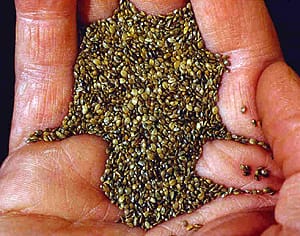SeedBroadcastBlog
By Kristina Hubbard
 Yesterday The Washington Post published a piece, titled: “Why perfect-looking produce can be less than ideal.” The author visited with OSA’s Dr. John Navazio to get the seed side of the story.
Yesterday The Washington Post published a piece, titled: “Why perfect-looking produce can be less than ideal.” The author visited with OSA’s Dr. John Navazio to get the seed side of the story.
“We still want beautiful food,” Navazio says, “but as we understand the story behind that food, we begin to look for a different kind of beauty.”
And that different kind of beauty includes more than looks, but flavor, taste, and nutrition, among a host of other traits that farmers need to manage pests and disease.
That beauty also means breeding more genetic diversity into our seed, which is especially important for organic farmers who face different production challenges and solutions than conventional farmers. Seed, in other words, is their first defense in the field.
Keep reading for Dr. Navazio’s take on how you can “look at every fruit and vegetable and learn about the life and environment that it came from.” The full article is here.
John Navazio, a plant breeder in Washington state, also sees a new trend in how we choose our produce.
“We still want beautiful food,” he says, “but as we understand the story behind that food, we begin to look for a different kind of beauty.”
No one can tell that story better than Navazio, who began his career at a commercial seed company and now works for the Organic Seed Alliance, a nonprofit organization that helps farmers develop seeds best suited for organic farming. According to Navazio, after decades of preferential breeding for yield, transportability and uniformity, our standard produce has lost much of its flavor and, in some cases, some of its nutrients. Initially, his goal was to improve upon these commercial breeds. But in 2002, when he started working with organic farmers at the seed alliance, he realized most modern crop varieties were simply not suitable for most organic farming.
“The available commercial seed stock was developed for a high-input industrial model where the land is flat, irrigated and treated with pesticides and fertilizers,” Navazio says. “Organic fruits and vegetables need to resist pests naturally by having more genetic diversity within each breed and by having a structure that wards off pests. They also need to be great nutrient scavengers, because their fertility is not handed to them on a platter.”
In addition to prizing hardiness, Navazio found, organic farmers had other priorities that were different from those of big conventional growers. First and foremost, they wanted fruits and vegetables that had great taste, and preferably ones that packed a bigger nutritional punch.
On the other hand, Navazio found that shelf life and transportability were less essential to most organic farmers because they sold locally and had less lag time between field and plate. A high yield was less important, because local customers accept more imperfections and so less of the harvest needed to be discarded. Mitcham told me that as much as 30 percent of all produce on some larger farms is relegated to animal feed or canned food or is left to rot in the field.

